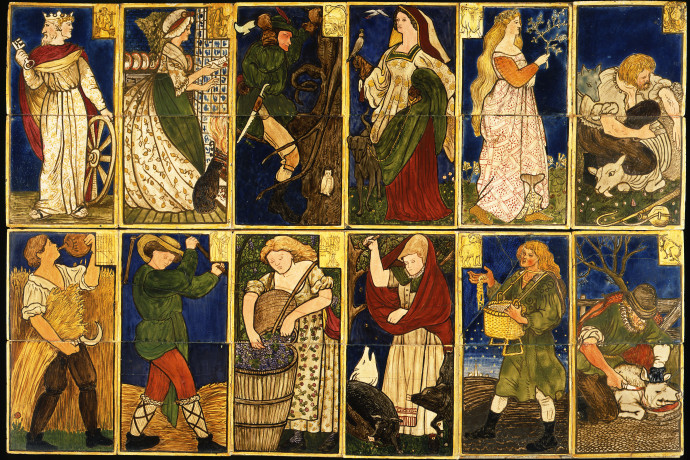The figures in these tiles each symbolise a month of the year and depict a relevant seasonal activity or pastime. The ‘Labours of the months’ was an artistic theme that featured in medieval and early-Renaissance art. The rural activities were, as they are here, also sometimes paired with the signs of the zodiac.
This panel was created in the very early days of Morris’s company. A similar series was commissioned for the firm by G.F. Bodley in 1862 for the over mantel in the Dining Hall of Queens’ College, Cambridge. Although substantially the same, there are several differences: at Queens’ the figure symbolising June is a man with a scythe (by Morris or Madox Brown) rather than Madox Brown’s Sheep-Shearer; the Queens’ tiles lack the small inset pictures of zodiac symbols designed by Webb; and at Queens’ 6-inch rather than these 5-inch tiles are used.
These tiles were all painted by Lucy Orrinsmith nee Faulkner (the February tile is signed with her LJF monogram in the lower right yellow border) and designed by Morris and friends. Some of the artists are known, yet there is uncertainty as to the precise attribution of all the figure panels:
January- Possibly Morris/Burne-Jones or Webb
February- Burne-Jones
March- Madox Brown
April- Morris
May- Madox Brown
June- Madox Brown
July- possibly Morris
August- Rossetti
September- possibly Rossetti
October- Burne-Jones
November- Madox Brown
December- Rossetti
Like a number of other tiles from the 1860s, this series of The Labours of the Month seems to have been acquired for display in Morris & Co.’s shop in the early twentieth century, when the subjects April (Flower-bearer) and May (Falconry) were set in the incorrect sequence. Their earlier history is unknown.

